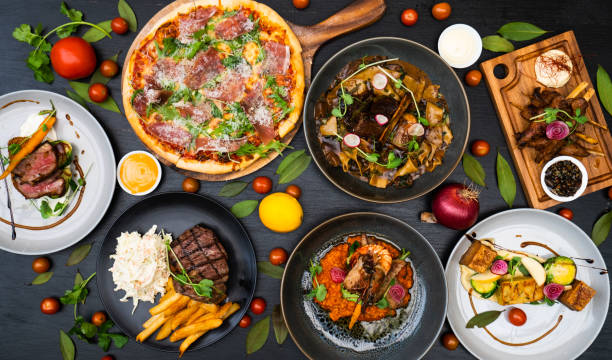In an age where dietary choices and calorie counts are meticulously scrutinized, understanding what 2,000 calories look like can be a powerful tool for making informed decisions about your daily nutrition. Whether you’re on a weight management journey, aiming to maintain a healthy lifestyle, or simply curious about the impact of food intake, visualizing a 2,000-calorie day can provide valuable insights into the composition of a balanced diet.
Why 2,000 Calories?
The daily recommended calorie intake of 2,000 calories is often cited as a general guideline for the average adult. However, it’s crucial to note that individual calorie needs can vary based on factors like age, gender, activity level, and overall health goals. For some, 2,000 calories might be more or less than what they require. It’s always a good idea to consult with a healthcare professional or nutritionist to determine the right caloric intake for your specific needs.
Visualizing 2,000 Calories
Let’s explore what a 2,000-calorie day looks like, broken down into three main meals (breakfast, lunch, and dinner) and two snacks. The key is to create a balanced and satisfying meal plan that encompasses a variety of food groups, providing essential nutrients and energy.
Breakfast (Approximately 400-500 Calories)
A nutritious breakfast sets the tone for the day and should include a mix of carbohydrates, protein, and healthy fats.
- Oatmeal: A bowl of oatmeal (about 1 cup cooked) made with ½ cup of rolled oats, 1 cup of skim milk (or plant-based milk), and topped with sliced strawberries, a sprinkle of chia seeds, and a teaspoon of honey. This provides essential fiber, protein, and antioxidants to kickstart your day (Approx. 350-400 calories).
- Scrambled Eggs: Two scrambled eggs cooked in a teaspoon of olive oil and served with a side of sautéed spinach and a small whole-grain toast (Approx. 100-150 calories).
Snack (Approximately 150 Calories)
A mid-morning snack can keep your energy levels steady until lunch.
- Greek Yogurt with Berries: A small container of Greek yogurt with a handful of mixed berries and a drizzle of honey (Approx. 150 calories).
Lunch (Approximately 500-600 Calories)
Lunch should be a balanced combination of lean proteins, whole grains, and plenty of vegetables.
- Grilled Chicken Salad: A generous salad with grilled chicken breast, mixed greens, cherry tomatoes, cucumbers, and a balsamic vinaigrette dressing (Approx. 400-450 calories).
- Quinoa: A side of quinoa cooked with herbs and a squeeze of lemon juice (Approx. 100-150 calories).
Snack (Approximately 150-200 Calories)
Afternoon snacks can help stave off hunger and keep you focused.
- Carrot Sticks with Hummus: A serving of carrot sticks paired with a couple of tablespoons of hummus (Approx. 150-200 calories).
Dinner (Approximately 600-700 Calories)
Dinner should be a well-balanced meal with a focus on lean protein and vegetables.
- Baked Salmon: A portion of baked salmon seasoned with herbs and a squeeze of fresh lemon juice (Approx. 350-400 calories).
- Steamed Broccoli: A side of steamed broccoli seasoned with a dash of olive oil and garlic (Approx. 50-100 calories).
- Quinoa: Another serving of quinoa for a source of whole grains (Approx. 100-150 calories).
- Mixed Berries: A dessert of mixed berries (such as blueberries, raspberries, and blackberries) for a sweet ending (Approx. 100-150 calories).
Snack (Approximately 150-200 Calories)
A light and nutritious evening snack can help prevent late-night cravings.
- Almonds: A small handful of almonds for healthy fats and protein (Approx. 150-200 calories).
Total Calorie Breakdown
- Breakfast: 400-500 calories
- Snack 1: 150 calories
- Lunch: 500-600 calories
- Snack 2: 150-200 calories
- Dinner: 600-700 calories
- Snack 3: 150-200 calories
The above meal plan provides a total of approximately 2,000 calories, which is in line with the general daily recommendation for many adults. It also exemplifies a balanced diet, rich in essential nutrients, and incorporates a variety of food groups.
Key Takeaways
Understanding what 2,000 calories look like can help you make healthier choices and maintain a well-balanced diet. Here are some key takeaways:
- Distribute Calories Evenly: Divide your calorie intake throughout the day, including all main meals and snacks.
- Prioritize Nutrient-Dense Foods: Choose foods that are rich in nutrients, such as whole grains, lean proteins, fruits, and vegetables.
- Mindful Snacking: Snacks should be nutritious and portion-controlled, preventing excessive calorie consumption between meals.
- Stay Hydrated: Don’t forget the importance of staying hydrated with water or herbal teas.
- Individualized Needs: Remember that everyone’s caloric needs are unique, so consider your own requirements when planning your meals.
A 2,000-calorie day can be both satisfying and nutritious when it includes a balance of essential nutrients from a variety of food sources. Visualizing what 2,000 calories look like helps you make informed choices and supports your journey towards a healthier and more conscious approach to eating.
